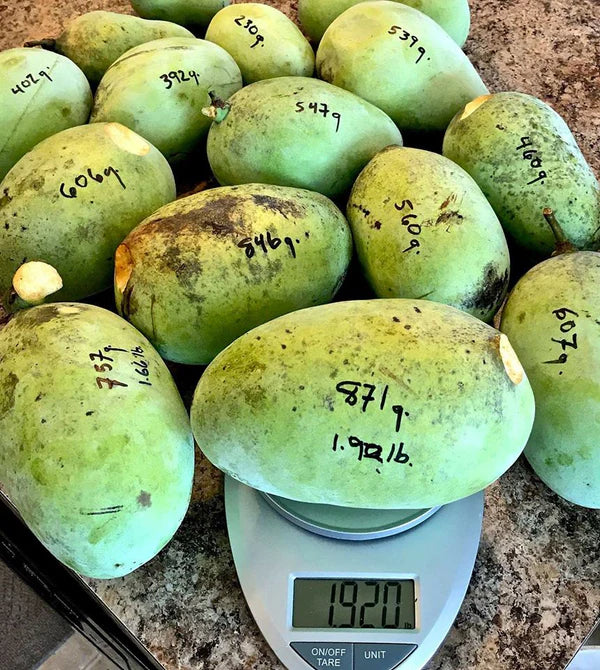Love it? Add to your wishlist
Your favorites, all in one place. Shop quickly and easily with the wishlist feature!
[message]
[title]
[message]


Veliyath Gardens
Couldn't load pickup availability
The American Pawpaw, botanically known as Asimina triloba, is one of the most intriguing and underappreciated fruit trees of North America. Native to the lush river valleys and hardwood forests of the eastern United States and southern Canada, this deciduous tree produces a uniquely tropical-tasting fruit in a completely temperate climate. Its charm lies not only in its rich flavor and nutritional profile but also in its centuries-old history that connects traditional cultures to the present-day garden.
Veliyath Gardens is proud to bring this rare and historical fruit tree to tropical regions—an opportunity for garden lovers to cultivate a tree that has fed generations and is now finding its way back into gourmet kitchens and health-conscious homes.
This extraordinary plant is known by various names that reflect its regional charm:
Botanical Name: Asimina triloba
Common Names: American Pawpaw, Prairie Banana, Custard Apple (North America), Poor Man’s Banana
Countries Where Known: United States, Canada, parts of Germany and New Zealand (in specialty cultivation)
It’s a fruit of folklore and family heritage, often passed down through generations by grafting or seed-saving.
The American Pawpaw is a small yet striking deciduous tree, ideal for medium-sized gardens and temperate to tropical landscapes.
Growth Habit: Slender and upright when young, spreading with maturity
Height: Grows up to 10 meters in favorable conditions
Foliage: Broad leaves that resemble tropical plants; golden-yellow in autumn
Preferred Environment: Moist, well-drained soil, partial shade when young, full sun in maturity
Fruiting Period: Typically starts producing in 4–6 years
Propagation: Can be grown from seed, but grafted plants yield quicker and more reliable fruiting
This tree grows gracefully and is well-suited to gardens seeking an ornamental fruit tree with minimal pest issues.
Often compared to tropical fruits, the pawpaw is considered a gourmet delicacy in the regions where it grows.
Appearance: Green-skinned when young, maturing to golden-brown with a soft, creamy interior
Pulp: Bright yellow-orange, custard-like in consistency
Flavor: A natural fusion of banana, mango, and caramel pudding
Seeds: Large, glossy black seeds embedded in the pulp
Ways to Enjoy:
Fresh off the tree
Blended into smoothies or shakes
Added to custards, muffins, or frozen as pawpaw ice cream
Its flavor is delicate and indulgent—a rare pleasure for fruit connoisseurs.
The American Pawpaw isn’t just a flavorful treat—it also holds impressive nutritional value and medicinal potential:
Rich in Antioxidants
Contains annonaceous acetogenins, compounds with promising anticancer and immune-regulating effects
Good Source of Micronutrients
Includes magnesium, iron, zinc, Vitamin C, and Vitamin A
High in Energy and Fiber
Supports digestion, improves satiety, and helps regulate blood sugar levels
Free from Fat and Cholesterol
Makes an excellent dessert replacement for those seeking natural nutrition
Its antioxidant content is especially noteworthy, and researchers continue to study its role in protecting cells and promoting long-term health.
The story of the pawpaw goes back centuries, embedded in both indigenous and settler history.
Used by Native Tribes: Tribes like the Shawnee, Cherokee, and Iroquois cherished the fruit for its nourishment and medicinal uses
Survival Food: Early American settlers and explorers, including Lewis and Clark, relied on pawpaw during expeditions
Historical Mentions: Frequently cited in 18th and 19th-century journals, songs, and folklore
Modern Revival: Heirloom gardeners and rare fruit enthusiasts are now reviving pawpaw trees across backyard gardens and organic farms
The fruit was once forgotten due to its short shelf life but is now being rediscovered as a treasure from America’s past.
This species is well-suited to a variety of growing conditions, especially with some initial care during its early stages.
Soil Requirements: Prefers loamy, fertile soil with good drainage
Watering: Consistent moisture, particularly in hot climates
Sunlight: Start in partial shade; once established, full sun increases fruit yield
Fertilization: Light feeding with compost or organic fertilizer is sufficient
Pollination: Planting two genetically different trees ensures better fruiting (cross-pollination needed)
A tree that rewards patience, the American Pawpaw fits beautifully into a biodiverse garden.
Since pawpaws ripen quickly and spoil within days, proper handling is important:
Best Fresh: Eaten within 48 hours of picking
Storage Tips:
Pulp can be scooped and frozen for up to six months
Used in baking, jams, or custards
Can be dehydrated for chewy, sweet slices
Overripe fruits are suitable for fermenting or blending into shakes
Its creamy pulp adapts well to modern recipes, making it ideal for creative cooks and nutrition seekers.
There’s something deeply rewarding about planting a tree with a rich cultural background, medicinal potential, and unique taste. The American Pawpaw offers all that and more:
It beautifies your garden with tropical-style foliage
Produces fruit unlike anything found in the market
Connects your garden to a deeper history of sustainability and healing
For families, wellness-focused individuals, and rare fruit enthusiasts, the pawpaw stands out as a meaningful, functional, and memorable addition.
At Veliyath Gardens, we believe in planting with purpose. The American Pawpaw (Asimina triloba) is not just another fruit—it’s a legacy tree. A gift from ancient forests, a treat for the palate, and a symbol of wellness, all growing quietly in your own backyard.
This rare and exquisite plant is now available at Veliyath Gardens. Reserve yours today and experience the taste of something truly extraordinary.
Preferred Environment: Moist, well-drained soil, partial shade when young, full sun in maturity
Fruiting Period: Typically starts producing in 4–6 years
Propagation: Can be grown from seed, but grafted plants yield quicker and more reliable fruiting
Rich in Antioxidants
Contains annonaceous acetogenins, compounds with promising anticancer and immune-regulating effects
Good Source of Micronutrients
Includes magnesium, iron, zinc, Vitamin C, and Vitamin A
It beautifies your garden with tropical-style foliage
Produces fruit unlike anything found in the market
Connects your garden to a deeper history of sustainability and healing



